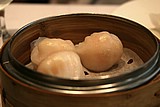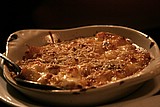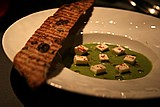Home |
Restaurants by City
|
Food Photography |
Archive | Philosophy |
![]()
Right now we are eating in Seattle, Washington.
|
Monday
2004
Permalink
|
Airplane Food, Netherlands, March 18, 2004 There wasn't really a non-stop flight option from Seattle to Italy so we had to pick a spot to stop. We ended up flying on Northwest/KLM through Amsterdam to Rome. I have tried to be disciplined about not asking you to spend your valuable time listening to me complain about airline food. Anyone who deems themselves good enough to get on stage at amateur night in their local comedy club has already covered that material in detail. However, when you eat something good on an airplane you should call it out. Airline meals are constrained by a series of challenges. You can't really cook anything on the plane, so all food must be made in advance. And then the airline equipment for cooling and heating food appears to have only two settings - frostbite cold, and corona hot. Invariably the wilted lettuce of your salad has some crystallized ice on it, and your hot "entree" looks like the surface of another planet. Just wait a few minutes and both will arrive at a more reasonable temperature. Unfortunately the food doesn't get any better in that time. And sure enough, our flight from Seattle to Amsterdam on Northwest had absolutely vile food. For some reason, despite the limitations, airlines insist (or customers demand) facsimiles of meals that should only be cooked in a real kitchen. Not warmed in an airplane galley. And yet, why is it that with non-U.S. airlines, I always have (and am often rewarded with) better quality plane food? I can't help but suspect it has something to do with the American obsession around quantity over quality. But whatever the reason, I always expect it to be better on flights originating outside the U.S. Not great food, but at least not completely atrocious. Our flight from Amsterdam to Rome didn't disappoint. They served us a simple breakfast. There was a box with pre-packaged fruit, yogurt, and muffin. O.K. The fruit was gross, and the cold muffin was too, but the yogurt was fine. But that wasn't the highlight, they also handed out from a basket what they called "cheese blintzes". In actuality they were smaller than fist-size medium brown soft rolls covered with a variety of yummy seeds (sunflower, pumpkin, etc.). In the middle of the bread was a slice of good tasting cheese. And the entire thing had been melted. Basically a simple grilled cheese sandwich, without the grilling, with a half-decent cheese, and a roll with nuts on it for flavor contrast to the cheese. Now this was something the heatboxes on an airplane could cook well. And these simple sandwiches were absolutely delicious. Why airlines think I want some horrifying approximation of pancakes, western omelet, and sausage instead of a simpler dish that might actually taste good, I don't know. Airlines should go with the strengths of their environment as opposed to trying to mask its weaknesses. And by the way, if my flight had departed from an American city, then my "cheese blintz" would have been a slice of orange American Cheese molten between two soggy pieces of a cheap variation on Wonder Bread. Yuck. One summer at summer camp at a certain point we got sick of the food being served in the cafeteria. We had a popcorn popper in our bunk. This wasn't an air popper, but the old kind that had a hot surface onto which you put oil, and then your unpopped kernels. We improvised and used it as a frying pan to make tuna melts. After stealing butter, bread, cheese, and tuna fish from the kitchen, we had some of the most golden and perfect tasting tuna melts I have ever eaten. All made in our popcorn popper. Bottom line: go with your strengths, and something edible may emerge.
|
|
Our Sponsors
Online Loans Conversion Strategies College Courses Surprise Birthdays Online Trading - Calendar and Event Schedules - Food Events and Calendars - Wine Events and Calendars - Digital Photography Resources - Jewish Gifts and Judaica - Howard Stern Podcast ponytailed blogger Jonathan Schwartz

Browse tastingmenu
Home |
Restaurants by City X |
Food Photography |
Archive | Philosophy |
![]()
Free eBooks: All About Apples
| Autumn Omakase
More:
Discussion |
Cool Food T-Shirts |
Ingredients
| Markets |
Recipes
Search |
Blog FAQ |
Other
Blogs
Best of tastingmenu
|
City View
Entry: July 6, 2006 |
Blue Plate
Entry: June 19, 2006 |
L'Atelier de Joël Robuchon
Entry: July 18, 2006 |
Browse by City
Boston | Chicago | Houston | Las Vegas | Los Angeles | Maui | New York | Philadelphia | Portland | San Francisco | Seattle | Toronto | Utah | Vancouver | Washington D.C.
Bangkok | Beijing | Hong Kong | Seoul | Tokyo
Amsterdam | Berlin | Italy | London | Madrid | Paris | Vienna
Browse by Month
2006
2005
2004
2003
2002
2001
Comments, questions, or feedback:
info / at / tastingmenu / dot / com
All pages Copyright (c) 2001-2006 tastingmenu.com
Last modified 11/27/06.



